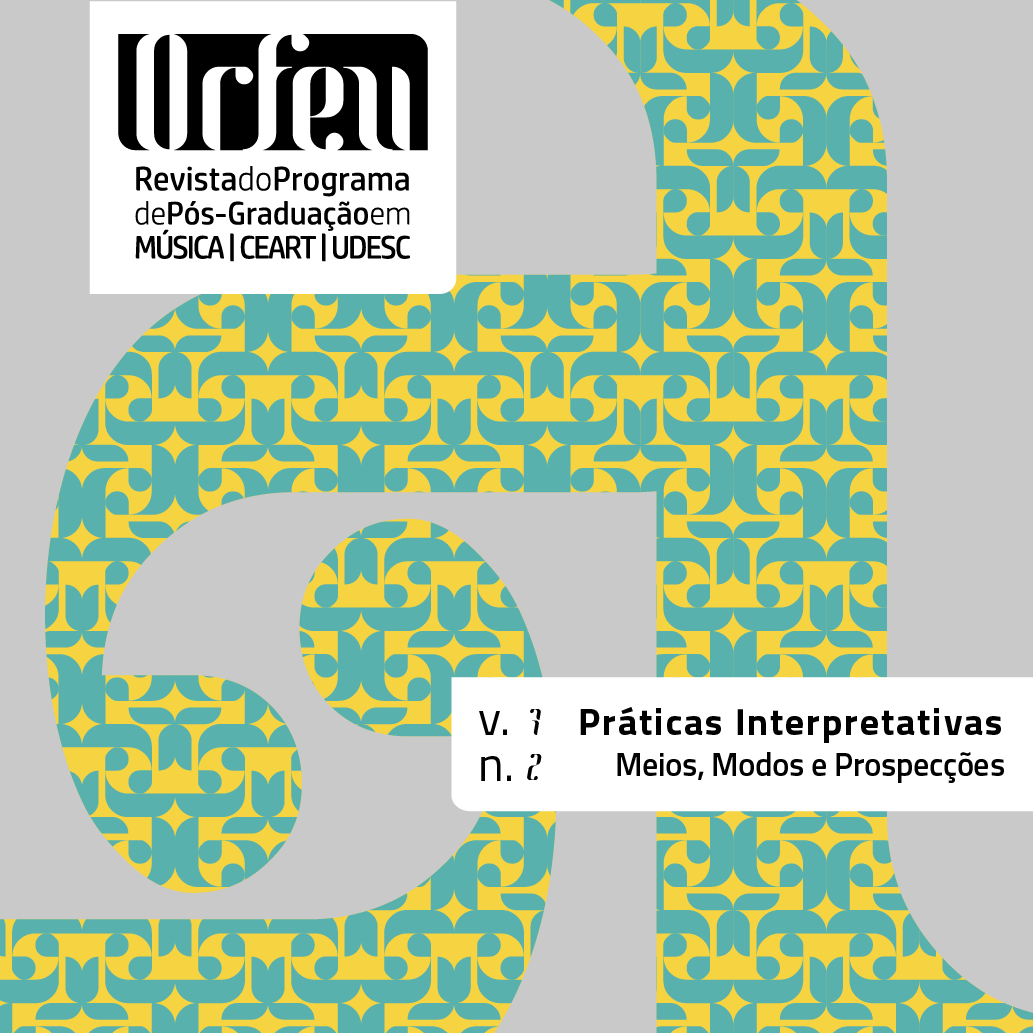Colonization, religion and sacred music in the North of Santa Catarina (1891-1923)
DOI:
https://doi.org/10.5965/2525530407022022e0201Keywords:
Paróquia de Santa Cruz de Canoinhas, Music History in Santa Catarina, Colonization in Santa Catarina, Sacred Music in Santa Catarina, Contestado WarAbstract
In this article we approach the relationship between the colonization process in the North Santa Catarina State and the concomitant development of the Paróquia Santa Cruz de Canoinhas, between the end of the 19th century and the beginning of the 20th, aiming a description of the presence of sacred music in that scenario. Using records from the curch, cartorials, iconography and bibliography of the areas covered, we present a mapping of the process of development of the musical structure at the Paróquia, having as temporal landmarks the beginning of the Jesuit missions in the region (1891) and the year of change of the first vicar (1923). The discussion is based on aspects of the Romanized Church of Pius IX and the determinations of the Motu Proprio “Inter pastoralis officci sollicitudines” of Pius X. It is understood that for the Saxon community of the region, the church and its apparatus (including music) were important for the life of the colonizers, composing the social network in their stays in the young villages of the state. We also aim to draw attention to the need to expand the musicological investigations about less privileged fields, such as the contryside of Santa Catarina.
Downloads
References
A REPÚBLICA. Pronunciamento de Cândido de Abreu. Ano XII, n° 267. Curitiba (PR), 22 de dezembro de 1897.
BESEN, Artulino José. Duas Formas de Catolicismo. O processo de romanização em Santa Catarina. In: “Encontros Teológicos”, Revista do ITESC 9 (17), 1994.
CABRAL, O. R. A Campanha do Contestado. 2.ed. rev. Florianópolis: Lunardelli, 1979.
CARVALHO, Aloysio Soares. Das sementes e raízes que fizeram surgir a “Schola Cantorum Santa Cecília” de Canoinhas, fundada em 26 de agosto de 1956, de utilidade pública. O Jornalzinho. Canoinhas (SC), setembro de 1977.
CASTAGNA, Paulo. Avanços e perspectivas na musicologia histórica brasileira. Salvador, 2004a. Palestra proferida na Universidade Federal da Bahia em novembro de 2004.
CORREIO DO NORTE. Jubileu áureo da Paróquia de Santa Cruz de Canoinhas. Ano 15, n° 693. Canoinhas (SC), 30 de junho de 1962.
DUARTE, Fernando Lacerda Simões. Resgates e abandonos do passado na prática musical litúrgica católica no brasil entre os pontificados de Pio X e Bento XVI (1903-2013). Tese de doutorado. São Paulo: UNESP, 2016.
GEVAERD, Ayres. Política e Políticos de Antanho. In Notícias de Vicente Só, I, n. 2, abr-mai-jun, Sociedade Amigos de Brusque, 1977.
HOLLER, Marcos Tadeu. Fontes sobre a história da música em Desterro. DAPesquisa, Universidade do Estado de Santa Catarina, Florianópolis, v. 3, n. 1, ano 5, ago. 2007/jul. 2008, 2008.
LUCAS, Maria Elizabeth. Perspectivas da pesquisa musicológica na América Latina: o caso brasileiro. In: I SIMPÓSIO DE MUSICOLOGIA, Curitiba, 1998. Anais. Curitiba: Fundação Cultura de Curitiba. 1998. p. 69-74.
PEREIRA, Tiago. Os estudos sobre a história da música em Santa Catarina: um panorama da produção acadêmica à luz da musicologia. In: Revista Orfeu, vol. 5, n. 3, 2020. p. 534-557.
SCHAETTE, Frei Estanislau. Frei Basílio Röwer, O.F.M. “Vida Franciscana”, n° 24, p. 188-194, 1958/dez.
SERBIN, Keneth. Padres, Celibato e Conflito Social: uma história da Igreja católica no Brasil. São Paulo: Companhia das Letras, 2008.
SINZIG, Frei Pedro, ofm. Frei Rogério Neuhaus. Petrópolis: Officinas da Editora Vozes. 1934.
STULZER, Frei Aurélio. A Guerra dos Fanáticos (1912-1916). A contribuição dos franciscanos. Vila Velha: Editora Vozes, 1982.
TOKARSKI, Fernando; BREHMER, Maria de Lourdes; BUENO, Viviane. Canoinhas: espaço, homem e memória. Curitiba: Sistema Base, 2011.
TOMPOROSKI, Alexandre; MUCHALOVSKI, Elói; GERONI, Ivone; LIMA, Pablo Bonifácio. Entre o invisível e o “herói”: novos olhares sobre o movimento sertanejo do contestado. In: “Profanações”. Ano 6, n. esp., p. 119-136, nov. 2019.
VINHAS DE QUEIROZ, M. Messianismo e conflito social: a guerra sertaneja do Contestado (1912-1916). Rio de Janeiro: Civilização Brasileira, 1966.
Documentos não-publicados
Livro Tombo. Tomo I. Paróquia Santa Cruz de Canoinhas. Canoinhas (SC), 1912-1951.
Registro de matrimônio. Leocadia Steffen, Alphéo Tolentino de Souza. Paróquia de Nossa Senhora do Desterro, Livro de Casamentos n° 25, Registro n° 16. Florianópolis (SC), 15 de abril de 1909. Disponível em: https://www.familysearch.org/ark:/61903/3:1:9Q97-Y3S1-2FX?cc=2177296&personaUrl=%2Fark%3A%2F61903%2F1%3A1%3AQGRT-DX6Z
Registro de matrimônio. Maria Werner, João Augusto Maluche. Igreja de São Luiz Gonzaga, Registros da Igreja, fl 35v. Brusque (SC), 31 de dezembro de 1874.
Registro de matrimônio. Rosalina Steffen, Pedro Nicolau Werner. Cartório Municipal de Lages, Livro de Matrimônios n° 9, Certificado n° 26. Lages (SC), 25 de fevereiro de 1912. Disponível em: https://www.familysearch.org/ark:/61903/3:1:S3HY-X9G9-2JB?i=102&cc=2016197
Registro de nascimento. Pedro José [Nicolau] Werner. Matriz São Luiz Gonzaga, Livro de Nascimentos, Registro n° 48. Brusque (SC), 6 de janeiro de 1886.
Registro de óbito. Rosalina Steffen Werner; Laudelino Werner; Claudio Werner. Paróquia Santa Cruz de Canoinhas, Livro de Óbitos, Registro no ano 1922, nos 32-34. Canoinhas (SC), 17 de outubro de 1912.
Registro de nascimento. Peter Steffen. Kastellayn, Rheinland, Prussia, 28 de fevereiro de 1858. Disponível em: https://www.familysearch.org/ark:/61903/1:1:N67R-RRX?from=lynx1UIV8&treeref=LX6Z-4NG
Published
How to Cite
Issue
Section
License
Copyright (c) 2022 Matheus Theodorovitz Prust

This work is licensed under a Creative Commons Attribution 4.0 International License.
Authors who submit their manuscripts to be published in this journal agree to the following terms:
1. Authors retain the copyright and grant to the journal the right of first publication, whilst simultaneously permitting their work to be licensed under the Creative Commons License Attribution, which allows the sharing of work with recognition of the authorship and initial publication in this journal.
2. Contributions in this journal are open access; this means they are based in free use, and non-commercial applications.






